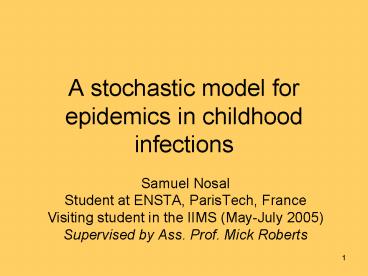A stochastic model for epidemics in childhood infections PowerPoint PPT Presentation
1 / 18
Title: A stochastic model for epidemics in childhood infections
1
A stochastic model for epidemics in childhood
infections
- Samuel Nosal
- Student at ENSTA, ParisTech, France
- Visiting student in the IIMS (May-July 2005)
- Supervised by Ass. Prof. Mick Roberts
2
An SIR model
- A class of models for epidemics with immunity
(especially in childhood infections) - Population divided into 3 groups Susceptibles,
Infected and Recovered - With or without demography birth, death,
emigration, immigration - In this project Without demography
3
(No Transcript)
4
Deterministic version
- Volterra-Lotka equations
- Initial conditions
- Constant population
Pairwise rate of infection time-1people-1
Removal per capita rate time-1
5
Main properties of the deterministic version
- An epidemic occurs only when
- Final number of susceptible people
- Not possible to have an explicit expression for
it - But unique ( )
- Linked to the stochastic model
6
A stochastic version
- A continuous-time Markov with states are in the
following set - Generator
- That leads to a discrete-time Markov chain
- Length of each state exponentially distributed
random variable with parameter - Transition probabilities
7
Matlab simulations
Deterministic
Markov chain
Epidemic
No Epidemic
Different scale on each row
8
Epidemic or not?
- Criterion to give the name epidemic when
- Probability distribution for
- Kolmogorov forward equations
- Computed in a large matrix
- Then sum of a few terms
9
Probability distribution (simulations)
- The only difference is the initial number of
infected people (1 vs 10) - Compute the probability matrix and then plot the
first column
10
Final number of infected people
- The evolution of with
respect to - The deterministic approximates
- Then we obtain the following expression
Depends on too
The deterministic
11
Matlab simulations
In red deterministic final number of susceptible
people
In red the approximation, which is given on the
previous slide
In blue the exact expected final number of
susceptible people
12
To a PDE and an SDE
- An epidemic as a chemical reaction
- Master equation
13
Fokker-Planck equation
- Taylor series to replace
- by terms in
- We only keep orders 0, 1 and 2 ? F-P eq.
- Initial and boundary conditions
14
From F-P equation to an SDE
- There is a theorem that gives us an SDE for a
random variable, whose probability distribution
obeys the F-P equation - But the theorems, that we have to prove (or not)
that there is a unique solution, are not valid
for example, coefficients are not Lipschitz
functions
15
Euler scheme
- It normally works only on nice SDEs
- But it gives some interesting results, that were
computed much faster than previously - Where
are Gaussian random variable normally
distributed
16
Euler scheme Matlab simulation
17
Conclusion
18
Thank youAu revoir et bonne continuation à tous

